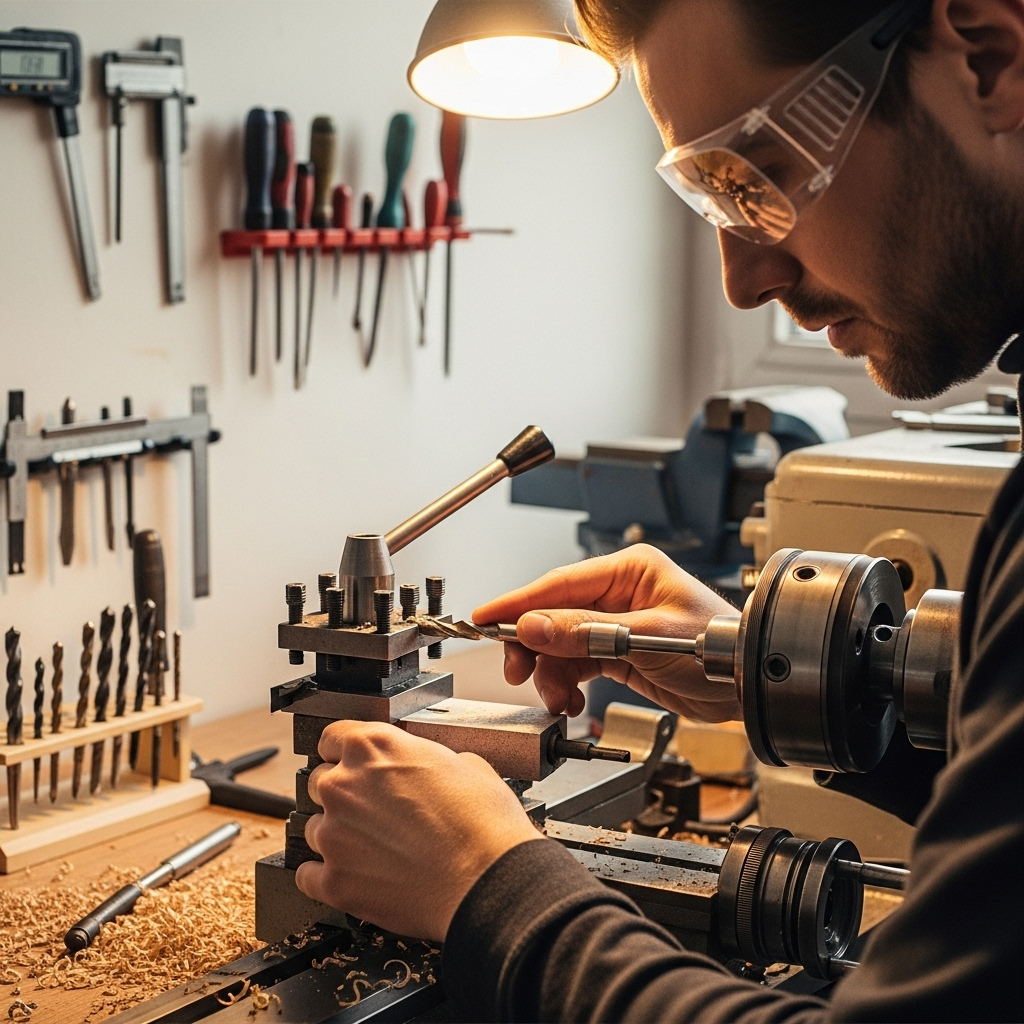A wood lathe vibration dampening mat is your go-to solution for stabilizing your lathe, improving workpiece finish, and creating a quieter, safer workshop environment. It effectively absorbs shakes and rattles, making your turning projects smoother and more enjoyable from the start.
Turning wood on a lathe can be an incredibly rewarding experience, bringing beautiful shapes to life. However, anyone who’s spent time with a wood lathe knows that vibrations can be a real party pooper. Those shimmies and shakes don’t just make noise; they can affect the quality of your work, and even make operating the lathe feel a bit dicey. If you’ve ever found yourself tightening bolts, wishing your lathe would just sit still, or dealing with a finish that’s less than smooth because of unwanted movement, you’re in the right place. This article is your friendly guide to the simple yet powerful solution: the wood lathe vibration dampening mat. We’ll break down exactly why these mats are so great and how they can transform your turning sessions.
Why Do Wood Lathes Vibrate?
It’s pretty common for wood lathes, especially when you’re starting out or using smaller models, to vibrate. This isn’t usually a sign that something’s broken; it’s just part of the process. Think about it: you’re spinning a piece of wood at hundreds, or even thousands, of revolutions per minute. If that wood isn’t perfectly balanced, or if the lathe itself isn’t perfectly rigid, those forces create energy that makes the whole machine move.
Several factors contribute to this:
- Wood Imbalance: The most common culprit! Wood isn’t uniform. Live edges, knots, irregular shapes, or even just a slight imbalance in how you’ve mounted your workpiece can cause it to wobble. As the wood spins, this wobble translates into vibrations.
- Lathe Construction: Cheaper or lighter-duty lathes often have less mass and rigidity. This means they’re more prone to shaking. Their components might not be as precisely fitted, contributing to a less stable base.
- Mounting Surface: Where you put your lathe matters! A flimsy workbench or a bouncy floor can amplify any vibrations the lathe produces. Imagine trying to balance a wobbly table on a springy mattress – it’s going to shake a lot more!
- Tooling and Technique: How you cut the wood can also play a role. Digging in too aggressively with your tools or using dull tools can create uneven forces that lead to vibrations.
- Drive Train Issues: Sometimes, problems with the motor, belt, or pulleys can introduce vibrations if they’re not running smoothly or are out of alignment.
These vibrations can lead to a frustrating experience. You might find your tools chattering against the wood, leaving a rough surface that requires extra sanding. Or, the lathe might “walk” across your bench or floor, which is not only annoying but also a safety concern.
The Magic of a Wood Lathe Vibration Dampening Mat
So, what’s the secret weapon against these stubborn shakes? It’s a surprisingly simple piece of equipment: a wood lathe vibration dampening mat. You might have seen them – thick, heavy-duty mats made of dense rubber or composite materials. They’re designed to sit directly underneath your lathe.
Think of it like putting shock absorbers on a car. When the wheels hit a bump, the shocks absorb the impact, making the ride smoother. A vibration dampening mat does something similar for your lathe. It acts as a buffer between the vibrating machine and the floor or workbench.
Here’s how it works its magic:
- Absorbs Energy: The dense, resilient material of the mat is excellent at soaking up the kinetic energy that causes vibrations. Instead of this energy being transferred and amplified by your floor, it’s dissipated within the mat itself.
- Reduces Noise: By absorbing vibrations, the mat also significantly cuts down on the noise your lathe makes. That incessant rattle and hum? Much quieter!
- Stabilizes the Machine: The weight and grip of the mat help keep your lathe firmly in place. It prevents that annoying “walking” and makes the entire machine feel more solid and planted.
- Protects Surfaces: Beyond just dampening vibrations, the mat also protects your workbench or floor from scratches, gouges, and oil stains that can happen from the machinery.
It’s a straightforward solution, but the benefits are huge. For beginners, it can make learning to turn much more enjoyable and less intimidating. For experienced turners, it means a cleaner cut, a better finish, and a more pleasant workshop.
Choosing the Right Mat: What to Look For
Not all mats are created equal. When you’re looking for a wood lathe vibration dampening mat, keep these key features in mind to ensure you get one that truly works for your setup.
Material Matters
The primary factor is the material. Most effective mats are made from dense, heavy-duty rubber or specialized composite materials.
- Dense Rubber: Often recycled materials like recycled tire rubber are used. This provides excellent weight and shock-absorbing properties. Look for mats that feel substantial and aren’t flimsy.
- Polyurethane or PVC Composites: These materials can also offer great vibration dampening and are often very durable and resistant to oils and chemicals.
Avoid thin foam mats or basic anti-fatigue mats. While they might offer some cushioning, they rarely have the density and mass needed to effectively absorb significant lathe vibrations.
Thickness and Weight
A good mat needs to have some heft.
- Thickness: Generally, thicker is better. Look for mats that are at least ½ inch (around 12mm) thick, with ¾ inch (around 19mm) or even 1 inch (around 25mm) being ideal for larger or particularly vibration-prone lathes.
- Weight: The mat itself should have some intrinsic weight. This mass contributes to its ability to absorb and dissipate vibrations.
Size and Fit
You want a mat that’s large enough to accommodate your lathe’s footprint, plus a little extra room around it.
- Coverage: Ensure the mat extends beyond the base of your lathe to capture vibrations at their source. A mat that’s too small won’t be as effective.
- Shape: While most are rectangular, check if the dimensions suit your lathe. You might need to cut a larger mat down to size, which is usually straightforward with a utility knife for rubber or composite materials.
Grip and Durability
You want the mat to stay put and last.
- Surface Grip: A textured surface on the top and bottom can help prevent the lathe from sliding around on the mat and the mat from sliding on the floor.
- Durability: The mat should be tough enough to withstand the weight of your lathe and any minor impacts from tools or dropped items. It should also resist wear and tear over time.
Price Point and Availability
Vibration dampening mats can range in price. While a super-cheap option might be tempting, investing in a quality mat will pay off in its effectiveness and longevity. Check with your local woodworking stores, industrial supply shops, or online retailers specializing in workshop equipment.
Here’s a quick comparison of common choices:
| Mat Type | Pros | Cons | Best For |
|---|---|---|---|
| Dense Rubber Mats (e.g., recycled tire rubber) | Excellent vibration dampening, durable, good grip, heavy-duty feel, often cost-effective. | Can be quite heavy, may have a slight rubber odor initially. | Most wood lathes, especially larger or more powerful models. Good for general workshop use. |
| Composite Material Mats (e.g., Polyurethane, specialized polymers) | High-performance vibration isolation, very durable, chemical resistant, can be lighter than rubber for similar performance. | Can be more expensive, might require specific cutting tools. | Serious hobbyists and professionals seeking top-tier performance and longevity. |
| Thick Industrial Felt Mats | Good noise reduction, provides some vibration dampening, lighter than rubber. | Less effective for heavy vibrations, can absorb liquids, less durable than rubber or composites. | Smaller, lighter lathes or as an additional layer for noise reduction. |
| DIY Options (e.g., layering plywood with cork or dense foam) | Customizable size and thickness, potentially cheaper if materials are on hand. | Effectiveness varies greatly, requires more effort and ingenuity, may not be as durable or stable. | Budget-conscious DIYers with time for experimentation. |
How to Use Your Wood Lathe Vibration Dampening Mat
Getting your mat in place is thankfully a very simple process, which is great news when you just want to get back to turning!
Step 1: Prepare Your Lathe and Workspace
- Turn off your lathe and unplug it. Safety first!
- Ensure the area where your lathe sits is clean and relatively level. Remove any dust, debris, or loose items.
- It’s also a good time to check that your lathe’s mounting bolts are snug. While the mat will help, a stable lathe base is always the first step.
Step 2: Position the Mat
- Unroll or place your new vibration dampening mat on the floor or workbench where the lathe is located.
- If you need to cut the mat to size, now is the time. Use a sharp utility knife, a carpet knife, or even a jigsaw with a suitable blade (check the manufacturer’s recommendations). Measure carefully and make clean, straight cuts. It’s often better to cut slightly larger than you think you need, so you can trim it down more precisely later if required.
- Ensure the mat lies flat and doesn’t have any kinks or folds that could cause instability.
Step 3: Place the Lathe on the Mat
- Carefully move your wood lathe onto the center of the mat. If you have a particularly heavy lathe, get help or use appropriate lifting aids to avoid injury.
- Center the lathe on the mat to ensure even support and optimal vibration absorption.
Step 4: Test and Adjust
- Plug in and turn on your lathe at a low speed.
- Listen and feel for any significant vibrations or movement.
- Gradually increase the speed and run a test piece (even a scrap piece of wood) on the lathe.
- Observe how the lathe performs at different speeds. The mat should noticeably reduce shakes and noise.
- If you notice any residual movement or if the mat feels like it’s not providing full contact, you might need to place shims (thin pieces of wood or metal) under the lathe’s feet to compensate for an uneven bench or floor. The mat should create a stable platform.
That’s it! You’ve successfully installed your vibration dampening mat. The difference should be immediately apparent during your next turning session.
Benefits Beyond Vibration Dampening
While the primary purpose of a wood lathe vibration dampening mat is clear, these handy accessories offer a few extra advantages that make them a worthwhile addition to any workshop.
Noise Reduction
This is a big one for many home woodworkers. Lathes can be noisy machines, and the sounds they produce can travel. A good vibration mat acts like a sound barrier, absorbing much of the noise that would otherwise be transmitted into the floor or structure of your workshop. This makes for a more pleasant working environment for you and can be a lifesaver if you have neighbors or housemates who are sensitive to workshop noise. For tips on further noise reduction, resources from organizations like the Occupational Safety and Health Administration (OSHA) on workplace noise control are invaluable, even for home workshops. (https://www.osha.gov/noise)
Improved Workpiece Finish
When a lathe vibrates, it’s harder to get a perfectly smooth cut. The tool can chatter on the surface of the wood, leaving behind ripples and imperfections that require extra sanding. By stabilizing the lathe, the vibration dampening mat allows for cleaner, more consistent cuts. This means less time spent on post-turning cleanup and a better quality finish directly off the lathe.
Enhanced Safety
A lathe that vibrates excessively can “walk” across your bench or floor. This movement can be a serious safety hazard, potentially pulling cords, knocking things over, or even causing the lathe to tip. By anchoring the lathe more securely and absorbing movement, the mat significantly improves the overall safety of operating your machine.
Protection for Your Workshop Surfaces
Lathes are heavy and can sometimes drip oil or finish. A good mat acts as protective barrier, preventing scratches, dents, and stains on your workbench or floor. This helps maintain the condition and appearance of your workspace.
Comfort While Turning
You might not think of this as a primary benefit, but a more stable and quieter lathe can make your turning sessions more comfortable. Less jarring vibration means less fatigue for you and a more relaxing experience at the lathe.
When Is a Mat Absolutely Essential?
While a vibration dampening mat is beneficial for almost any wood lathe user, there are certain situations where it moves from being just a good idea to being an absolute necessity.
For Smaller, Lighter Lathes
Budget-friendly or benchtop lathes are often made with lighter materials to keep costs down. These machines are inherently more prone to vibrating and can benefit immensely from the added mass and dampening a mat provides.
On Any Unstable Surface
If your lathe is sitting on a workbench that isn’t perfectly solid, or if your workshop floor has a bit of give (like an older wooden floor), the vibrations will be amplified. A dampening mat is crucial for isolating the lathe from these bouncy surfaces.
When Neighbors or Housemates are a Concern
If noise is a significant issue for you or those around you, a mat is one of the most effective ways to reduce the auditory footprint of your lathe.
For High-Speed Turning or Large Workpieces
Turning larger pieces of wood, especially those with irregular shapes or at higher speeds, can generate substantial centrifugal forces and vibrations. A mat adds the stability needed to handle these demanding operations safely.
For Achieving a Superior Finish
If you’re striving for the smoothest possible finish directly off the lathe, eliminating even minor vibrations is key. A mat helps achieve this consistency.
For New or Inexperienced Lathe Users
For beginners, learning to control the lathe can be challenging enough without fighting against excessive vibrations. A mat helps create a more stable and predictable learning environment, boosting confidence and making the learning curve less steep.
DIY Mat Options: When You Want to Build It Yourself
While purchasing a purpose-built wood lathe vibration dampening mat is usually the easiest and most effective route, there are some DIY approaches if you’re feeling particularly hands-on or on a tight budget. The key is to replicate the density and shock-absorbing qualities of a commercial mat.
Option 1: Thick Rubber or Industrial Mat Rolls
You can often find heavy-duty rubber sheeting or industrial anti-vibration mat rolls at hardware stores, building supply outlets, or even specialized industrial flooring suppliers.
- Material: Look for dense, solid rubber, not foam or carpeted versions.
- Thickness: Aim for at least ½ inch (12mm) thick.
- How-to: Measure your lathe’s footprint and cut a piece of the rubber mat to size using a sharp utility knife or carpet cutter.
This method is essentially buying raw material and cutting it yourself, often at a lower cost than a pre-sized mat.
Option 2: Layering Materials
For those who like to experiment, layering dense materials can create a custom dampening solution.
- Base Layer: Start with a sturdy piece of plywood or MDF (Medium-Density Fibreboard) that is at least ¾ inch (19mm) thick. This provides a solid, flat base.
- Middle Layer: Adhere a layer of dense cork sheet (often used for flooring underlayment) or a specialized dense foam (like those used for industrial machinery isolation) to the plywood base. Use a strong adhesive like construction adhesive.
- Top Surface (Optional but Recommended): For grip and further dampening, you could add a thin layer of dense rubber matting on top, or even just ensure the lathe’s feet have good contact with the layered surface.
This approach requires careful selection of materials and effective adhesion to prevent layers from separating. The total thickness should aim to be at least 1 inch (25mm) for significant effect.
It’s important to note that DIY solutions can vary greatly in their effectiveness. Always test your setup thoroughly and prioritize safety. If a DIY mat doesn’t seem to be significantly reducing vibrations, it’s better to invest in a commercial option to ensure a stable and safe turning experience. For more on workshop safety and sound, consulting resources from organizations like the National Institute for Occupational Safety and Health (NIOSH) can offer valuable insights. (https://www.cdc.gov/niosh/topics/noise/default.html)
Frequently Asked Questions (FAQ)
What is the primary purpose of a wood lathe vibration dampening mat?
The main goal of a wood lathe vibration dampening mat is to absorb and dissipate the vibrations produced by the lathe during operation. This leads to a more stable machine, quieter operation, and often a better quality finish on your workpiece.
How thick should a vibration dampening mat be?
For most wood lathes, a mat that is at least ½ inch (approximately 12mm) thick is recommended




